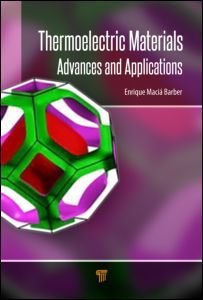Thermoelectric Materials Advances and Applications
Coordonnateur : Maciá Enrique

Environmental and economic concerns have significantly spurred the search for novel, high-performance thermoelectric materials for energy conversion in small-scale power generation and refrigeration devices. This quest has been mainly fueled by the introduction of new designs and the synthesis of new materials. In fact, good thermoelectric materials must simultaneously exhibit extreme properties: they must have very low thermal conductivity values and both electrical conductivity and Seebeck coefficient high values as well. Since these transport coefficients are interrelated, the required task of optimization is a formidable one. Thus, thermoelectric materials provide a full-fledged example of interdisciplinary research connecting fields such as solid-state physics, materials science engineering, and structural chemistry and raise the need of gaining proper knowledge of the role played by the electronic structure in the thermal and electrical transport properties of solid matter.
This book presents a detailed, updated introduction to the field of thermoelectric materials in a tutorial way, focusing on both basic notions and fundamental questions and illustrating the abstract concepts with suitable application examples. It discusses thermoelectric effects, the transport coefficients and their mutual relations, the efficiency of thermoelectric devices, and some notions on the characterization and related industry standards. It also reviews the two basic strategies for optimizing the thermoelectric performance of materials: the control of thermal conductivity and the power factor enhancement. It discusses structural complexity approach, focusing on complex enough lattice structures with heavy atoms in the unit-cell or nanostructured systems characterized by low-dimensional effects, and introducing different kinds of bulk materials of growing chemical and structural complexity. It also discusses the electronic structure engineering approach that focuses on obtaining a guiding principle, in terms of an electronic band structure tailoring process, and describes the role played by the electronic structure in the thermoelectric performance of different materials.
Basic Notions. Fundamental Aspects. The Structural Complexity Approach. The Role of the Electronic Structure. Beyond the Periodic Order. Organic Semiconductors and Polymers.
Enrique Maciá-Barber is professor of condensed matter physics at the Universidad Complutense de Madrid, Spain. His research interests include the thermoelectric properties of quasicrystals and DNA-based devices. He is author of several monographs and the book Aperiodic Structures in Condensed Matter: Fundamentals and Applications (CRC Press, Boca-Raton, 2009).
Date de parution : 05-2015
15.2x22.9 cm
Thèmes de Thermoelectric Materials :
Mots-clés :
FOM Value; Te Performance; Basic Notions; Fermi Level; The Structural Complexity Approach; Complex Metallic Alloys; The Role of the Electronic Structure; Brillouin Zone; Beyond the Periodic Order; American Chemical Society; Organic Semiconductors and Polymers; Thermal Conductivity; Te Property; American Physical Society; Charge Carriers; Lattice Thermal Conductivity; Decagonal Quasicrystals; Guest Atoms; Half Heusler Compounds; Molecular Junction; Aperiodic Crystals; Icosahedral Quasicrystals; Conduction Band; Valence Band; Quasiperiodic Plane; Thermal Conductivity Values; Sb Atoms; Transition Metal; Te Device; Electrical Resistivity



